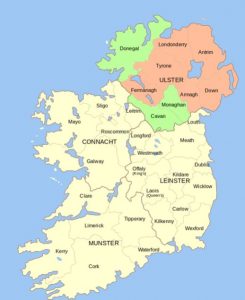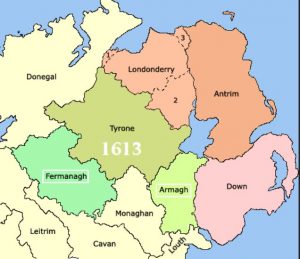

George Washington certainly had no doubts of their loyalty and dependability When he stated, “If defeated everywhere, I shall make my last stand for liberty among the Scotch, Irish of my native Virginia, Surely a most revealing tribute from one who had suffered many heart breaking disappointments, betrayals, and defeats in his campaigns.
Plantation System: The plantation system was remarkable change from the feudal labor system that operated in England for hundreds of years. For the first time, common farmers could obtain the rights to land, create and operate their farms and benefit directly, rather than to be essentially slaves to nobility who owned all the profits and gave the workers a subsistence. Under the plantation system, a common farmer could directly benefit from his labor. The land and the farmer became far more productive.
Rack Rent: The plantation system was financed by granting weathy men, primarily in London, land where the King claimed authority. In the early 1600s, this was in Ulster, where the English had recently defeated the traditional Irish, Nova Scotia, and the Carolinas’ in America. The land owners leased this land to those willing to settle there. Leases were long term, typically 99 years. In the early 1700s, the leases in Ulster were up for renewal, and the landowners insisted in excessive increases. In addition, they recognize that the land was being over-farmed, harming the value, so many of the new leases required that only 10% of the land be farmed, with rotation to restore the land. These terms caused the land to be unprofitable and was the reason that many left for America.
The Scotch Irish & their place in Us History
They didn’t like the Native Irish, and they didn’t think much of the English either – They came to stay
The Scotch Irish, possibly more correctly called the Ulster Irish, are an ethnic mixture, but certainly have earned the title as a distinctive group of people. The population which lived in the lowlands of Scotland had mixed with many cultures, as the area was invaded over the centuries by Romans, English, Germanic tribes, Norse tribes, and others. The Highland Scots lived in the hills, formed protective clans, and did not intermarry as much with the outside world, so they retained their genetic characteristics and distinctive culture. They were tough such that even the Romans gave up on conquering them. Instead, they built the Hadrian Wall to isolate them from England during their occupation.
Scotch Irish or Ulster Irish origins
The Scotch Irish identity relates to their history in Northern Ireland (Ulster), which began with the reign of King James VI/I (King James VI of Scotland and King James I of England).
Northern Ireland was devastated and nearly devoid of activity and people following the Nine-Year War, waged between the Catholic Irish and the English. The English defeated the Irish, leaving the land essentially vacant in the years leading to the reign of King James VI/III ca 1603. King James VI/I was a Scot, who recognized he had a problem with the lowland Scots who lived between Highland Scots and England. He also recognized a large unemployed population in London that would be troublesome if not fixed.
Scotland, near the border with England, was devastated because of years of poor farming methods and its use as a battleground between Scotch and English armies. Those living there no longer bothered to plant crops as it was unlikely they would ever get the chance to harvest them since the English and Scots would destroy the fields by using them as a battleground. The people were called “Reavers” as they made their living raiding English across the border and Scots to the north for their necessities. A solution was required.
After some interesting adventures, Hugh Montgomery and James Hamilton, well-connected Englishmen, obtained 3 counties from Con O’Neil with the permission of the King. They began to settle some of the Lowland Scots into Northern Ireland to farm the land. The settlements were quite successful. The King then began a program known as the plantation system to settle many more from Scotland and London into the five counties in Northern Ireland. Most of the London contingent found they did not like the harsh conditions and returned to London. The plantation system was also used successfully in the Carolinas’ in America and Nova Scotia. The plantation system grants land to rich Londoners, giving them land at a reasonable cost. They then rent the land with long-term leases to those who occupy it and farms that can operate independently. Those working the land have a stake in the success of the plantations as they can keep a share of the wealth they create after rent is paid. The idea was revolutionary in the era, as the land had always been held by an autocratic Barron who owned all that was produced and then provided subsistence to the workers or peasants as needed to keep them from revolting.
The Ulster Plantations
These plantations were successful, and the land became productive again. At first, the primary money crop was wool.
England kept firm control of the Northern Ireland economy. All exports were required by law to be transported to London, where duties could be charged before being sold in America and Europe. As the quantity and quality of wool from Ulster began to compete with Scotland, protective tariffs were assessed, making wool less profitable. The primary money crop became flax. The flax products were enhanced by new technology brought to the area by Huguenots, refugee Protestants from Germanic countries who were persecuted. Flax from the area was of exceptionally fine quality.
Religious wars
Through the 17th century, England flipped through Catholic and Protestant rulers, including an exceptionally disastrous period ruled by the Puritans under Cromwell. The Presbyterian Ulster-Irish experienced good and bad times, as the Church of England tolerated them while the Catholic monarchs wished to eliminate them. Cromwell’s Puritans initially wanted to eliminate them but changed their minds when they realized they were needed to help him eliminate the Catholics.
Native Irish in Ulster were given no rights and were treated as criminals. The few left in the area survived in hiding and survived by raiding the working farms.
Under Catholic King James II, in 1689, 30,000 Protestants were held under siege in the walled city of Londonderry. The siege was maintained for 105 days until it was broken by William of Orange soon after he replaced King James II. The native Irish were ultimately defeated at the Battle of the Boyne a year later, saving the Presbyterian Ulster Irish from being expelled or exterminated. The siege of Londonderry was particularly brutal such that it was still a factor in the “Troubles” of the 20th Century.
Life becomes More Difficult
Early in the 19th century, life became tough for the Ulster Irish. The Londonderry siege was still on their minds, but actions by the London landholders cut into their livelihoods. As the long-term leases expired, owners levied huge rent increases and imposed unreasonable land use restrictions. The rent increases were called “rack-rent”. Ulster Irish farmers were not good farmers, and farmland was becoming run down. Restrictions were imposed to restore the land but were so severe that tenants could not make a living. These restrictions included requirements to till only 1/10th of the land, leaving the remainder untouched, rotating the tilled land each year. These restrictions made the Ulster Irish look at America as the promised land.
New England Migration
Early migration was to Boston. Cotton Mather, of the Salem witchcraft trial fame, wrote letters to ministers in Ulster inviting them to migrate to New England. His motivation was to create settlements of tough populations to the north and west of Boston that could keep Canadian Indians from being such a problem to the Puritans. Frequently, the migration was by entire congregations. In August of 1717, there were 5 Irish ships in the Boston Harbor.
Frequent ships with cargos of Ulster Irish became a problem. Colonial settlements did not have surpluses in their barns and warehouses to sustain a large influx of new people. Some ships were forced to go north to form new settlements. At least one ship was iced into the harbor at what is now Portland, Maine, and had to wait until spring to form the settlement. All who had to suffer through the winters without preparation suffered. While the new settlement at New Londonderry survived, many new settlements failed.
Some of the Ulster Irish had the means to pay the ship’s captains their fare for the crossing and others did not. Those without means were transported with the understanding that they would become indentured servants after they arrived. The captains then sold their contracts at a nice profit upon arrival. The passengers were required to remain aboard the ship until their contracts were sold.
Contracts for indentured services were normally for seven years. Those with trades were sold quickly, while less skilled passengers could spend some weeks aboard the ship. The contracts were tough on women as the contract period was extended by three years if they became pregnant.
Authorities required anyone who came ashore to have a sponsor or a means of support. There were little or no facilities for charity. New England towns were brutal to people who needed assistance, as they were escorted to the town’s boundary and told not to return.
Our Family of McConoughey’s
David McConoughey from my mother’s family arrived in America in 1731 and immediately settled in Waltham, Massachusetts. Land in Waltham at the time was owned by wealthy residents of Boston. David and his wife worked there until 1747, when he moved to Blandford, Massachusetts, with his three children. According to family legend, little Samuel had to walk the entire distance when he was only four. It is reasonable to assume that David came to America and served his term as an indentured servant for seven years, plus additional time because of the three children born in Waltham.
Pennsylvania and Appalachia
Authorities in Boston soon began to discourage new arrivals from Ulster, but immigration to the Delaware and Pennsylvania ports increased. There was ample land in Pennslyvania, Maryland, and Delaware, but as land became scarcer or burned out, they spread south along the eastern side of the Appalachian Mountains. Protestant Germans, the Pennslyvania Dutch, and the Ulster Irish got along fairly well but stayed apart and did not mix.
The Revolutionary War
Ulster Irish played a huge role in the Revolutionary War. While populations on the coast had been, to a large degree, Loyalists, the Ulster-Irish considered America their promised land, and they were prepared to defend that position. They had no love of the English or royalty. They responded in great numbers when shots were fired at Concord, the beginning of the Revolutionary War, and they made up a large portion of Washington’s Army. Many of his Generals were of Scotch-Irish descent, as were many of the signers of the Declaration of Independence.
The Term Irish
Ulster Irish were called the Irish until the Irish Catholic migration in the mid-19th century. Ulster Irish ended when the American Revolution began. While some Irish Catholics were in the colonies before the Revolutionary War, most came to America later, beginning in the middle of the 19th century. However, the two distinctly different populations frequently are confused.